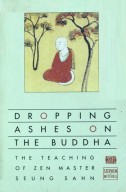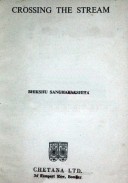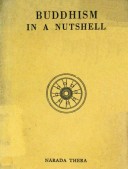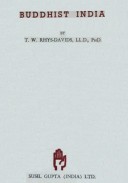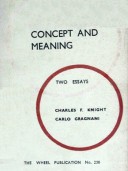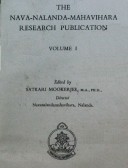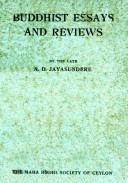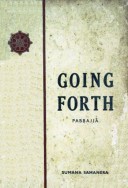Tìm Sách
Sách tiếng Anh-English >> Dropping Ashes On The Buddha
Thông tin tra cứu
- Tên sách : Dropping Ashes On The Buddha
- Tác giả : Seung Sahn
- Dịch giả :
- Ngôn ngữ : Anh
- Số trang : 231
- Nhà xuất bản : Grove Press-NewYork
- Năm xuất bản : 1978
- Phân loại : Sách tiếng Anh-English
- MCB : 1210000008185
- OPAC :
- Tóm tắt :
PREFACE
Zen teaching is like a window. At first, we look at it, and see only the dim reflection of our own face. But as we learn, and our vision becomes clear, the teaching becomes clear. Until at last it is perfectly transparent. We see through it. We see all things: our own face.
This book is a collection of Seung Sahn Soen-sa’s teaching in America—dialogues, stories, formal Zen interviews, Dharma Speeches, and letters. The words arise as situations arise. Each situation is a game, and a matter of life and death.
The title comes from a problem which Soen-sa gives his students for homework. It goes like this:
Somebody comes into the Zen Center with a lighted cigarette, walks up to the Buddha-statue, blows smoke in its face and drops ashes on its lap. You are standing there. What can you do?
This person has understood that nothing is holy or unholy. All things in the universe are one, and that one is himself. So everything is permitted. Ashes are Buddha; Buddha is ashes. The cigarette flicks. The ashes drop.
But his understanding is only partial. He has not yet understood that all things are just as they are. Holy is holy; unholy is unholy. Ashes are ashes; Buddha is Buddha. He is very attached to emptiness and to his own understanding, and he thinks that all words are useless. So whatever you say to him, however you try to teach him, he will hit you. If you try to teach by hitting him back, he will hit you even harder. (He is very strong.)
How can you cure his delusion?
Since you are a Zen student, you are also a Zen teacher. You are walking on the path of the Bodhisattva, whose vow is to save all beings from their suffering. This person is suffering from a mistaken view. You must help him understand the truth: that all things in the universe are just as they are.
How can you do this?
If you find the answer to this problem, you will find the true way.
INTRODUCTION
Deep in the mountains, the great temple bell is struck. You hear it reverberating in the morning air, and all thoughts disappear from your mind. There is nothing that is you; there is nothing that is not you. There is only the sound of the bell, filling the whole universe.
Springtime comes. You see the flowers blossoming, the butterflies flitting about; you hear the birds singing, you breathe in the warm weather. And your mind is only springtime. It is nothing at all.
You visit Niagara and take a boat to the bottom of the Falls. The downpouring of the water is in front of you and around you and inside you, and suddenly you are shouting: YAAAAAA!
In all these experiences, outside and inside have become one. This is Zen mind.
Original nature has no opposites. Speech and words are not necessary. Without thinking, all things are exactly as they are. The truth is just like this.
Then why do we use words? Why have we made this book?
According to Oriental medicine, when you have a hot sickness you should take hot medicine. Most people are very attached to words and speech. So we cure this sickness with word-and-speech medicine.
Most people have a deluded view of the world. They don’t see it as it is; they don’t understand the truth. What is good, what is bad? Who makes good, who makes bad? They cling to their opinions with all their might. But everybody’s opinion is different. How can you say that your opinion is correct and somebody else’s is wrong? This is delusion.
If you want to understand the truth/ you must let go of your situation, your condition, and all your opinions. Then your mind will be before thinking. “Before thinking” is deal mind. Clear mind has no inside and no outside. It is just like this. “Just like this” is the truth.
An eminent teacher said.
If you want to pass through this gate, do not give rise to thinking.
This means that if you are thinking, you can’t understand Zen. If you keep the mind that is before thinking, this is Zen mind.
So another Zen Master said,
Everything the Buddha taught was only to correct your thinking.
If already you have cut off thinking, what good are the Buddha’s words?
The Heart Sutra says, “Form is emptiness, emptiness is form.” This means, “no form, no emptiness.” But the true meaning of “no form, no emptiness” is, “form is form, emptiness is emptiness.”
If you are thinking, you won’t understand these words. If you are not thinking, “just like this” is Buddha-nature.
What is Buddha-nature?
Deep in the mountains, the great temple bell is struck.
The truth is just like this.
Seung Sahn
TABLE OF CONTENTS
Preface…………………………ix
Introduction…………………………xi
- Zen Is Understanding Yourself…………………………3
- The Zen Circle…………………………5
- My Dharma Is Too Expensive…………………………8
- Advice to a Beginner…………………………10
- Inside, Outside…………………………19
- A Child Asks About Death…………………………20
- Who Needs a Zen Master…………………………22
- You Are Attached! …………………………23
- About the Heart Sutra…………………………25
- Not Difficult, Not Easy…………………………28
- A Dharma Speech…………………………30
- What Is One Plus Two? …………………………32
- What To Do About Noise…………………………33
- You Must Become Completely Crazy…………………………34
- The Story of Ko Bong…………………………36
- How Can the Buddha Be Smiling? …………………………39
- Apples and Oranges…………………………41
- Kong-an Blues…………………………42
- The 84,000 Levels of Enlightenment…………………………46
- What Is Freedom? …………………………49
- The Great Treasure…………………………50
- The Moon of Clear Mind…………………………51
- What Have You Brought Here? …………………………52
- Enlightened and Unenlightened Are Empty Names………………54
- Why We Chant……………………56
- A Dharma Speech……………………58
- The Story of Won Hyo……………………60
- Porcupines in Rat-Holes……………………63
- Practicing Zen……………………66
- It Is Your Mind That Is Moving……………………68
- Bodhisattva Attachment……………………70
- Five Kinds of Zen……………………71
- The Color of Snow……………………75
- Don’t-Know Mind, Continued……………………76
- Zen and Tantra……………………79
- The 10,000 Questions Are One Question……………………80
- Buddha Is Grass Shoes……………………82
- Three Interviews……………………84
- When the Lights Go Off, What?……………………86
- Testing the Mind……………………87
- What Is Death?……………………89
- Wanting Enlightenment……………………91
- The True Way for Women……………………93
- Can You See Your Eyes?……………………94
- Special Medicine and Big Business……………………96
- Miracles……………………99
- A Dharma Speech……………………102
- A Little Thinking, A Little Sparring……………………104
- No-Attainment Is Attainment……………………107
- True Sitting Zen……………………111
- Samadhi vs. Satori……………………113
- Lin-Chi’s KATZ……………………115
- Nirvana and Anuttara Samyak Sambodhi……………………117
- Zen and the Arts……………………118
- Plastic Flowers, Plastic Mind……………………121
- True Emptiness……………………123
- You Must Wake Up! ……………………124
- More Ashes on the Buddha……………………125
- The Story of Su Tung-p’o……………………129
- What Nature Is Saying to You……………………132
- It……………………135
- Small Love and Big Love……………………138
- Does the Cat Have Buddha-Nature? ……………………140
- Out of the Depths……………………141
- Funny……………………144
- The Story of Kyong Ho……………………145
- Bodhisattva Sin……………………148
- A Dharma Speech……………………150
- The True Way……………………151
- Sex Mind=Zen Mind? ……………………153
- Keen-Eyed Lions and Blind Dogs……………………156
- Original Sound, Original Body……………………158
- The Story of Mang Gong……………………163
- Mang Gong Explains His KATZ……………………167
- The Transmission of No-Mind……………………168
- Inside the Cow’s Belly……………………169
- Today Is Buddha’s Birthday. The Sun Is Shining……………171
- Dok Sahn and His Stick……………………173
- All Things Are Your Teachers……………………174
- Who Makes One? ……………………184
- What Is Your Star? ……………………186
- The Story of Sul……………………187
- Dialogue with Swami X……………………191
- Big Mistake……………………196
- Language-Route and Dharma-Route……………………196
- The Tathagata……………………200
- Bodhidharma and I……………………201
- Correspondence with an Ordained American Lawyer………………202
- Saving All People……………………211
- Dialogue at Tal Mah Sah……………………212
- The Boat Monk……………………213
- When the Bell Is Rung, Stand Up……………………217
- The Story of Mun Ik……………………218
- What Did You Say? ……………………220
- Much Ado About Nothing……………………221
- An Ambush in the Fields of Dharma……………………222
- Un-Mun’s Short-Answer Zen……………………223
- Ko Bong Explains a Poem……………………224
- The Story of Seung Sahn Soen-Sa……………………226
- What Is Love? ……………………232
 Facebook
Facebook
 Google
Google
 Google+
Google+
